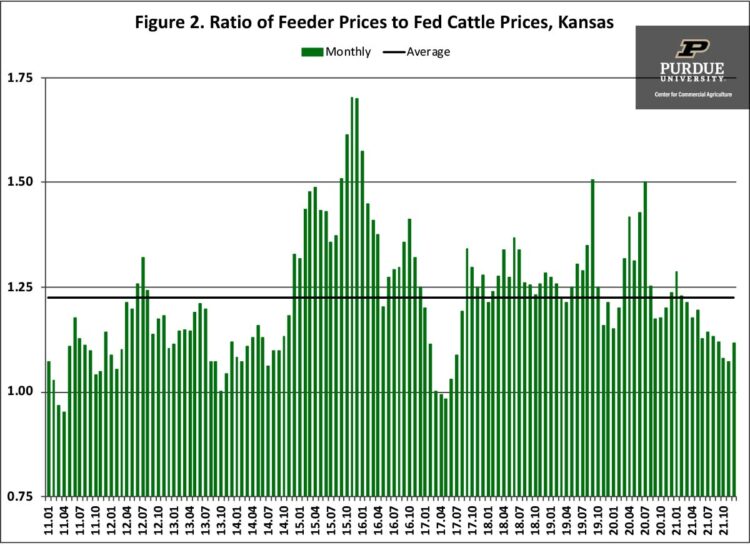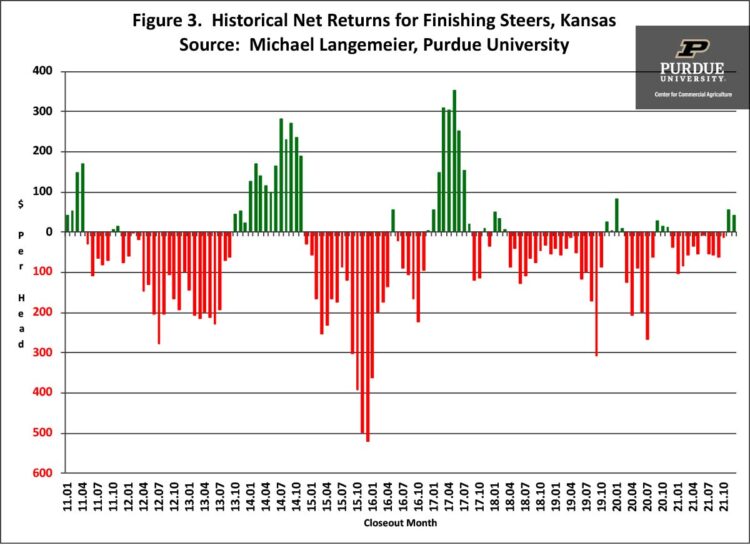January 7, 2022
Cattle Finishing Net Returns Prospects for 2022
By Michael Langemeier
Due to relatively strong fed cattle prices, cattle finishing net returns ended 2021 on a positive note. Will these positive net returns continue into 2022? This article examines feeding cost of gain, breakeven prices, and net return estimates for 2021, and provides projections for the first half of 2022. Several data sources were used to compute net returns. Average daily gain, feed conversion, days on feed, in weight, out weight, and feeding cost of gain were obtained from monthly issues of the Focus on Feedlots newsletter (here). Futures prices for corn and seasonal feed conversion rates were used to project feeding cost of gain for the next several months. Net returns were computed using feeding cost of gain from monthly issues of the Focus on Feedlots newsletter, fed cattle prices and feeder cattle prices reported by the Livestock Marketing Information Center (LMIC) (here), and interest rates from the Federal Reserve Bank of Kansas City.
Feeding Cost of Gain
Figure 1 illustrates monthly feeding cost of gain from January 2011 to December 2021. The estimates for November and December 2021 represent projections. Feeding cost of gain averaged approximately $100 per cwt. in 2021 ranging from a low of $82.28 in January to $109.54 in October. Relatively high corn prices will likely keep feeding cost of gain during the next six months above $100 per cwt. Feeding cost of gain for the first quarter of 2022 is expected to range from $104 to 107 per cwt. For the second quarter of 2022, feeding cost of gain is expected to range from $100 to $104 per cwt., with the largest feeding cost of gain occurring in April. The lower feeding cost of gain for May and June is not due to lower corn price projections. Rather, feed conversion is typically lower during these two months than feed conversions from January through April.
Feeding cost of gain is sensitive to changes in feed conversions, corn prices, and alfalfa prices. Regression analysis was used to examine the relationship between feeding cost of gain, and feed conversion, corn prices, and alfalfa prices. Results are as follows: each 0.10 increase in feed conversion increases feeding cost of gain by $1.20 per cwt., each $0.10 per bushel increase in corn prices increases feeding cost of gain by $0.88 per cwt., and each $5 per ton increase in alfalfa prices increases feeding cost of gain by $0.45 per cwt.
Feeder to Fed Cattle Price Ratio
The ratio of feeder to fed cattle prices since January 2011 is illustrated in figure 2. Since January 2011, this ratio averaged 1.22. The feeder to fed price ratio was one standard deviation below (above) this average for 18 (19) months since January 2011. The average net return for the months in which the ratio was below one standard deviation of the average was $118 per head. In contrast, the average loss for the months in which the ratio was above one standard deviation was $265 per head. The average ratio for the 19 months with a feeder to fed price ratio that was above one standard deviation of the long-run average was 1.49. The feeder to fed cattle ratio averaged 1.24 and 1.17 in the first and second quarter of 2021, and 1.13 and 1.09 in the third and fourth quarters. Thus, the feeder to fed price ratio has been below the long-run average since the first quarter of 2021. This trend is expected to continue into the new year. The projected feeder to fed cattle price ratio for the first half of 2022 is expected to range from 1.15 to 1.20.
Net Return Prospects
Monthly steer finishing net returns from January 2011 to December 2021 are presented in Figure 3. It is important to note that net returns were computed using closeout months rather than placement months, and that the estimates for November and December 2021 are projections. Net losses in the first quarter and second quarter of this year averaged $81 and $31, respectively. The loss in the second quarter was primarily due to relatively high feed costs because as noted above the feeder to fed cattle ratio was below the long-run average during this quarter. Losses in the third quarter averaged $56 per head. Average net returns are projected to be approximately $30 per head in the fourth quarter of 2021, ranging from a loss of $13 in October to a net return of $56 in November.
Historical and breakeven prices for the last ten years, as well as projected breakeven prices through the December of 2021, are illustrated in figure 4. Breakeven prices for the first and second quarter of 2021 averaged approximately $119 and $122 per cwt. Average breakeven prices for the third quarter and fourth quarter were approximately $125 and $130, respectively. Due to relatively higher feeder prices, breakeven prices for the first and second quarters of 2022 are expected to range from $134 to $137. Combining these breakeven prices with Livestock Marketing Information Center (LMIC) fed cattle price projections results in expected losses in the first quarter and small positive net returns in the second quarter of 2022. Due to the amount uncertainty related to the current market environment, our typical caveats apply to these projections. Net return prospects could change rapidly.
Conclusions
This article discussed recent trends in feeding cost of gain, the feeder to fed price ratio, breakeven prices, and cattle finishing net returns. Average cattle finishing losses in 2021 were estimated to be approximately $35 per head. Current breakeven and fed cattle price projections suggest that net returns will be similar to those in 2021 in the first quarter of 2022, and closer to breakeven levels in the second quarter of 2022.
Citations
Focus on Feedlots, Animal Sciences and Industry, Kansas State University, www.asi.k-state.edu/about/newsletters/focus-on-feedlots, accessed January 5, 2022.
Livestock Marketing Information Center, www.lmic.info/, accessed January 5, 2022.
TAGS:
TEAM LINKS:
RELATED RESOURCES
UPCOMING EVENTS
December 1 & 8, 2025
Join Purdue Extension for a two-part workshop designed to help you gain a clearer understanding of tax planning essentials. The first session on December 1 will focus on the fundamentals of farm taxes, with particular emphasis on strategies that can be used in a low net income year. The second session on December 8 will focus on key tax strategies and will allow plenty of time for questions. Registration cost is only $20.
Read MoreDecember 15, 2025
This program provides in-depth coverage of agricultural and farm tax issues. In addition to covering timely tax issues, we will cover disaster tax issues, depreciation and expensing farm assets, retirement planning for farms, and tax planning in low-income years. This year’s webinar will be co-taught by a team from Ohio State and Purdue Universities.
Read MoreJanuary 27 or 28, 2026
Farm Shield is more than a conference, it’s a commitment to helping agricultural families build resilience and plan for a secure future. Don’t miss this opportunity to protect your legacy!
Read More



